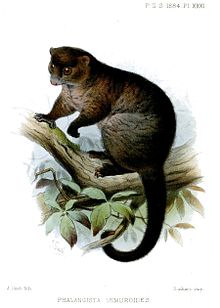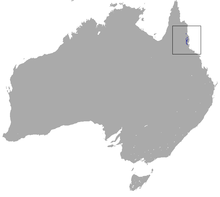Lemur ring pouch
| Lemur ring pouch | ||||||||||||
|---|---|---|---|---|---|---|---|---|---|---|---|---|

Lemur Ringbuttler near Mareeba |
||||||||||||
| Systematics | ||||||||||||
|
||||||||||||
| Scientific name of the genus | ||||||||||||
| Hemibelideus | ||||||||||||
| Collett , 1884 | ||||||||||||
| Scientific name of the species | ||||||||||||
| Hemibelideus lemuroides | ||||||||||||
| (Collett, 1884) |
The Lemur Ringbeutler ( Hemibelideus lemuroides , Syn . : Hemibelideus cervinus Logman, 1915 ) is a species of bag mammal from the family of the Ringbeutler (Pseudocheiridae). It bears its name because of the similarities with the Malagasy lemurs .
features
The fur of the lemur ringbuck is extremely dense and woolly, it is colored a dark chocolate brown on the top and yellow-gray on the underside. A rarer color morph is cream-colored on the back, and its belly is also yellow-gray. It has been described as a separate species in the past. The tail is also densely hairy except for the rear area on the underside and can be used as a pronging tail. The head is relatively small, the short ears barely protrude from the fur. They have suggested flight membranes between the limbs, which indicate a close relationship to the giant gliding bag. These animals reach a head and trunk length of 31 to 40 centimeters, have a 23 to 38.4 centimeter long tail and a weight of 810 to 1170 grams.
Way of life
Lemur pseudocheiridae live in two small areas in the humid tropics of Queensland ( Australia ). One population lives between Ingham and Cairns at an altitude of about 400 meters above sea level, the other, smaller population at an altitude of 1100 meters on the plateau of Mount Carbine west of Mossman .
Lemur Ringbeutler are pronounced tree dwellers, who usually stay at heights of eleven to twenty meters, and thus higher than their relatives, the Green Ringbeutler ( Pseudochirops archeri ) and the Herbert River Ringbeutler ( Pseudochirulus herbertensis ). They are considered agile and good climbers and can jump from tree to tree for about two to three meters. They spend the day sleeping in tree hollows in order to search for food at night. They often live together in small family groups (males and females or females with offspring), when they eat they sometimes join together to form larger groups (up to eight animals). Their diet consists primarily of leaves. A total of 37 species of rainforest trees are known to eat their leaves, especially the laurel family , elaeocarpaceae and rhombus family .
The females' pouch contains two teats, but mostly a single young is born. After birth, it spends the first few months of its life in its mother's pouch, later it rides on her back. The births usually take place between August and November, young animals riding on the mother's back are seen from October to April.
The natural enemies of the lemur ringbuck include the amethyst python ( Simalia kinghorni ), the red owl ( Ninox rufa ), the spotted soot owl ( Tyto multipunctata ) and the giant sacred marten ( Dasyurus maculatus ).
Systematics
The lemur ring pouch was described in 1884 by the Norwegian zoologist Robert Collett under the scientific name Phalangista lemuroides and assigned to the genus Hemibelideus by the same author in the same year . The genus has remained monotypical to this day. Within the family of the Ringbeutler (Pseudocheiridae) the Lemuren-Ringbeutler forms the subfamily Hemibelideinae together with the three kinds of the giant gliding bagler ( Petauroides ).
Danger
Part of their area of distribution is protected, the animals are likely to be relatively common there, but due to clearing and fragmentation of their habitat, they have become rare in other areas. They are particularly threatened by clearing and fragmentation of their habitat, as they do not come to the ground to switch between different forest fragments, only eat the leaves of trees that are typical for primary forests and need natural, sufficiently large tree hollows to sleep during the day. The IUCN lists the species as Near Threatened .
literature
- Stephen Jackson: Family Pseudocheiridae (Ring-tailed Possums and Greater Gliders). Page 665 in Don E. Wilson & Russell A. Mittermeier : Handbook of the Mammals of the World: Monotremes and Marsupials: Volume 5. ISBN 978-84-96553-99-6
- Ronald M. Nowak: Walker's Mammals of the World . Johns Hopkins University Press, 1999 ISBN 0801857899
Individual evidence
- ↑ Hemibelideus lemuroides ( page no longer available , search in web archives ) Info: The link was automatically marked as defective. Please check the link according to the instructions and then remove this notice. at Wilson & Reeder's Mammal Species of the World. Posted by Colin P. Groves. Retrieved April 27, 2015
- ↑ Hemibelideus lemuroides in the endangered Red List species the IUCN 2009. Posted by: Burnett, S. & Winter, J., 2008. Accessed October 19 of 2009.

